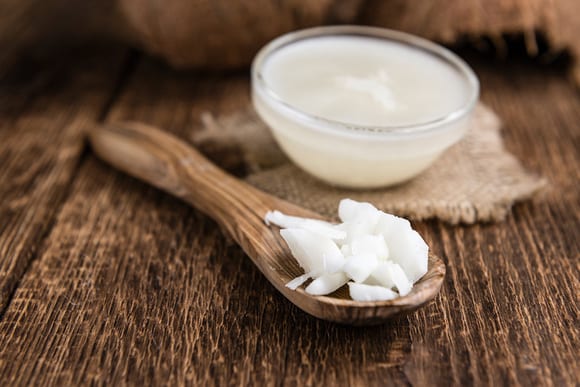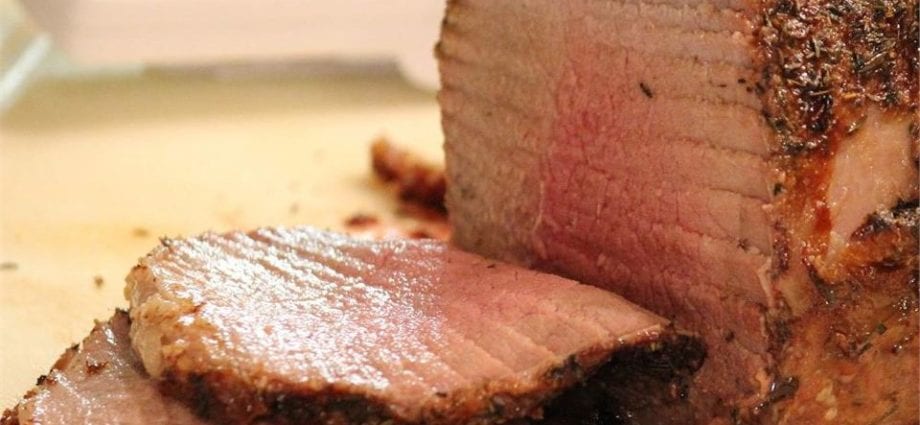
Nutritional value and chemical composition.
The table shows the content of nutrients (calories, proteins, fats, carbohydrates, vitamins and minerals) per 100 grams edible part.
| Nutrient | Quantity | Norm** | % of the norm in 100 g | % of the norm in 100 kcal | 100% normal |
| Caloric value | 190 kCal | 1684 kCal | 11.3% | 5.9% | 886 g |
| Proteins | 26.41 g | 76 g | 34.8% | 18.3% | 288 g |
| Fats | 9.36 g | 56 g | 16.7% | 8.8% | 598 g |
| Water | 63.88 g | 2273 g | 2.8% | 1.5% | 3558 g |
| Ash | 0.99 g | ~ | |||
| Vitamins | |||||
| Vitamin A, RE | 1 μg | 900 μg | 0.1% | 0.1% | 90000 g |
| retinol | 0.001 mg | ~ | |||
| Vitamin B1, thiamine | 0.08 mg | 1.5 mg | 5.3% | 2.8% | 1875 g |
| Vitamin B2, riboflavin | 0.197 mg | 1.8 mg | 10.9% | 5.7% | 914 g |
| Vitamin B4, choline | 87.9 mg | 500 mg | 17.6% | 9.3% | 569 g |
| Vitamin B5, pantothenic | 0.74 mg | 5 mg | 14.8% | 7.8% | 676 g |
| Vitamin B6, pyridoxine | 0.399 mg | 2 mg | 20% | 10.5% | 501 g |
| Vitamin B9, folate | 6 μg | 400 μg | 1.5% | 0.8% | 6667 g |
| Vitamin B12, cobalamin | 3.46 μg | 3 μg | 115.3% | 60.7% | 87 g |
| Vitamin D, calciferol | 0.1 μg | 10 μg | 1% | 0.5% | 10000 g |
| Vitamin D3, cholecalciferol | 0.1 μg | ~ | |||
| Vitamin E, alpha tocopherol, TE | 0.14 mg | 15 mg | 0.9% | 0.5% | 10714 g |
| Vitamin K, phylloquinone | 1.6 μg | 120 μg | 1.3% | 0.7% | 7500 g |
| Vitamin PP, NE | 4.593 mg | 20 mg | 23% | 12.1% | 435 g |
| Betaine | 32.6 mg | ~ | |||
| Macronutrients | |||||
| Potassium, K | 339 mg | 2500 mg | 13.6% | 7.2% | 737 g |
| Calcium, Ca | 18 mg | 1000 mg | 1.8% | 0.9% | 5556 g |
| Magnesium, Mg | 22 mg | 400 mg | 5.5% | 2.9% | 1818 g |
| Sodium, Na | 79 mg | 1300 mg | 6.1% | 3.2% | 1646 g |
| Sulfur, S | 264.1 mg | 1000 mg | 26.4% | 13.9% | 379 g |
| Phosphorus, P | 211 mg | 800 mg | 26.4% | 13.9% | 379 g |
| Trace Elements | |||||
| Iron, Fe | 2.52 mg | 18 mg | 14% | 7.4% | 714 g |
| Manganese, Mn | 0.014 mg | 2 mg | 0.7% | 0.4% | 14286 g |
| Copper, Cu | 80 μg | 1000 μg | 8% | 4.2% | 1250 g |
| Selenium, Se | 27 μg | 55 μg | 49.1% | 25.8% | 204 g |
| Zinc, Zn | 9.93 mg | 12 mg | 82.8% | 43.6% | 121 g |
| Essential Amino Acids | |||||
| Arginine * | 1.776 g | ~ | |||
| valine | 1.222 g | ~ | |||
| Histidine * | 0.871 g | ~ | |||
| Isoleucine | 1.156 g | ~ | |||
| leucine | 2.186 g | ~ | |||
| lysine | 2.376 g | ~ | |||
| methionine | 0.77 g | ~ | |||
| threonine | 1.196 g | ~ | |||
| tryptophan | 0.303 g | ~ | |||
| phenylalanine | 1.03 g | ~ | |||
| Replaceable amino acids | |||||
| alanine | 1.527 g | ~ | |||
| Aspartic acid | 2.432 g | ~ | |||
| Hydroxyproline | 0.133 g | ~ | |||
| glycine | 1.176 g | ~ | |||
| Glutamic acid | 4.301 g | ~ | |||
| Proline | 1.087 g | ~ | |||
| serine | 1.037 g | ~ | |||
| tyrosine | 0.937 g | ~ | |||
| Cysteine | 0.281 g | ~ | |||
| Sterols | |||||
| Cholesterol | 84 mg | max 300 mg | |||
| Fatty acid | |||||
| Transgender | 0.402 g | max 1.9 г | |||
| monounsaturated trans fats | 0.402 g | ~ | |||
| Saturated fatty acids | |||||
| Saturated fatty acids | 3.751 g | max 18.7 г | |||
| 14: 0 Myristic | 0.217 g | ~ | |||
| 16: 0 Palmitic | 2.039 g | ~ | |||
| 17: 0 Margarine | 0.109 g | ~ | |||
| 18: 0 Stearin | 1.372 g | ~ | |||
| 20: 0 Arachinic | 0.002 g | ~ | |||
| 24: 0 Lignoceric | 0.012 g | ~ | |||
| Monounsaturated fatty acids | 4.691 g | min 16.8 г | 27.9% | 14.7% | |
| 14: 1 Myristoleic | 0.045 g | ~ | |||
| 16: 1 Palmitoleic | 0.279 g | ~ | |||
| 17: 1 Heptadecene | 0.08 g | ~ | |||
| 18: 1 Olein (omega-9) | 4.269 g | ~ | |||
| 18: 1 cis | 3.866 g | ~ | |||
| 18: 1 trans | 0.402 g | ~ | |||
| 20: 1 Gadoleic (omega-9) | 0.019 g | ~ | |||
| Polyunsaturated fatty acids | 0.431 g | from 11.2 to 20.6 | 3.8% | 2% | |
| 18: 2 Linoleic | 0.36 g | ~ | |||
| 18: 2 Omega-6, cis, cis | 0.33 g | ~ | |||
| 18: 2 Conjugated Linoleic Acid | 0.03 g | ~ | |||
| 18: 3 Linolenic | 0.017 g | ~ | |||
| 18: 3 Omega-3, alpha linolenic | 0.017 g | ~ | |||
| 20: 4 Arachidonic | 0.051 g | ~ | |||
| 20: 5 Eicosapentaenoic (EPA), Omega-3 | 0.002 g | ~ | |||
| Omega-3 fatty acids | 0.02 g | from 0.9 to 3.7 | 2.2% | 1.2% | |
| 22: 6 Docosahexaenoic (DHA), Omega-3 | 0.001 g | ~ | |||
| Omega-6 fatty acids | 0.381 g | from 4.7 to 16.8 | 8.1% | 4.3% |
The energy value is 190 kcal.
Roast beef, American style, beef, boneless, scapula eye, meat only, trimmed to 0 ”fat, selected, fried rich in vitamins and minerals such as: choline – 17,6%, vitamin B5 – 14,8%, vitamin B6 – 20%, vitamin B12 – 115,3%, vitamin PP – 23%, potassium – 13,6%, phosphorus – 26,4%, iron – 14%, selenium – 49,1%, zinc – 82,8%
- Mixed is a part of lecithin, plays a role in the synthesis and metabolism of phospholipids in the liver, is a source of free methyl groups, acts as a lipotropic factor.
- Vitamin V5 participates in protein, fat, carbohydrate metabolism, cholesterol metabolism, the synthesis of a number of hormones, hemoglobin, promotes the absorption of amino acids and sugars in the intestine, supports the function of the adrenal cortex. Lack of pantothenic acid can lead to damage to the skin and mucous membranes.
- Vitamin V6 participates in the maintenance of the immune response, inhibition and excitation processes in the central nervous system, in the conversion of amino acids, in the metabolism of tryptophan, lipids and nucleic acids, contributes to the normal formation of erythrocytes, maintenance of the normal level of homocysteine in the blood. Insufficient intake of vitamin B6 is accompanied by a decrease in appetite, a violation of the condition of the skin, the development of homocysteinemia, anemia.
- Vitamin V12 plays an important role in the metabolism and conversion of amino acids. Folate and vitamin B12 are interrelated vitamins and are involved in blood formation. Lack of vitamin B12 leads to the development of partial or secondary folate deficiency, as well as anemia, leukopenia, thrombocytopenia.
- Vitamin PP participates in redox reactions of energy metabolism. Insufficient vitamin intake is accompanied by disruption of the normal state of the skin, gastrointestinal tract and nervous system.
- potassium is the main intracellular ion that takes part in the regulation of water, acid and electrolyte balance, participates in the processes of nerve impulses, pressure regulation.
- Phosphorus takes part in many physiological processes, including energy metabolism, regulates acid-base balance, is a part of phospholipids, nucleotides and nucleic acids, is necessary for the mineralization of bones and teeth. Deficiency leads to anorexia, anemia, rickets.
- Hardware is a part of proteins of various functions, including enzymes. Participates in the transport of electrons, oxygen, ensures the course of redox reactions and activation of peroxidation. Insufficient consumption leads to hypochromic anemia, myoglobin-deficient atony of skeletal muscles, increased fatigue, myocardiopathy, atrophic gastritis.
- Selenium – an essential element of the antioxidant defense system of the human body, has an immunomodulatory effect, participates in the regulation of the action of thyroid hormones. Deficiency leads to Kashin-Beck disease (osteoarthritis with multiple deformities of the joints, spine and extremities), Keshan disease (endemic myocardiopathy), hereditary thrombastenia.
- Zinc is a part of more than 300 enzymes, participates in the processes of synthesis and decomposition of carbohydrates, proteins, fats, nucleic acids and in the regulation of the expression of a number of genes. Insufficient consumption leads to anemia, secondary immunodeficiency, liver cirrhosis, sexual dysfunction, and fetal malformations. Recent studies have revealed the ability of high doses of zinc to disrupt copper absorption and thereby contribute to the development of anemia.
You can find a complete guide to the most useful products in the appendix.
Tags: calorie content 190 kcal, chemical composition, nutritional value, vitamins, minerals, how is it useful Roast beef, American style, beef, boneless, scapular flesh eye, only meat, trimming to 0 ”fat, selected, fried, calories, nutrients, useful properties Roast beef, American style, beef, boneless, scapula eye, meat only, trimmed to 0 ”fat, selected, fried
2021-02-17










